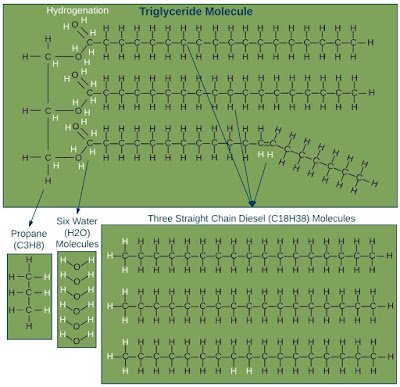Hydrotreating (HVO) – Concepts, feedstocks and specifications
Section: ADVANCED BIOFUELS
Series: HVO
- Hydrotreating (HVO) – Concepts, feedstocks
and specifications
- Posts: HVO
|
Key of the process: Treatment with hydrogen.
|
In the HVO production process, hydrogen is used
to remove the oxygen from the triglycerides producing a mix of linear
paraffins, CO2 and water. Then, the product of the first stage is
isomerized, always in presence of hydrogen, in order to branch the linear
chains for improving the cold flow properties of the final products. Thus, HVO
are mixtures of paraffinic hydrocarbons, free of sulphur and aromatics and with
a very high cetane number. The hydrocarbons created are similar to existing
diesel fuel components which allows blending in any desired ratio without any
concerns regarding fuel quality.
Figure 1. Triglyceride hidrogenation (extracted
from Reference 4)
Other term used
to refer to HVO is “Hydroprocessed
Esters and Fatty Acids” (HEFA).
Other terms used
to refer to the main HVO product are “Hydrogenation Derived Renewable Diesel” (HDRD), “Non Ester Renewable Diesel”,
“Renewable Hydrocarbon
Diesel”, “Hydro-generated
Biodiesel” (HBD), “Green
Diesel”.
The European
standard EN 15940 uses the definition ”Paraffinic Diesel Fuel from Hydrotreatment”.
|
The term HVO emerged in last decade when only
vegetable oils (e.g. rapeseed, soybean and corn oil) were used as feedstocks.
Today, more and more of HVO is produced from industrial waste (tall oil and
fats) and used cooking oils. Thus, HVO is no longer accurate describing the
origin of the fuel. However, it cannot be changed easily since it is common in
the European regulation, fuel standards and biofuel quality recommendations. Also,
“Hydrotreated” referring to fuel processing should be preferred instead of
”Hydrogenated” as the latter is commonly linked to manufacturing of margarine.
The main product of the HVO process is diesel.
However, it has to be noted that an HVO plant is a type of biorefinery and the
production of a wide range of products is possible. Apart from diesel, an HVO
facility can be used to produce jet fuel, naptha and GPLs.
Since HVO are hydrocarbons, they meet
conventional diesel fuel requirements:
- EN 15940
This standard covers also synthetic
Fischer-Tropsch products GTL, BTL and CTL. Before that, paraffinic diesel fuel
was specified by CEN Technical Specification TS 15940:2012 and CEN Workshop
Agreement CWA 15940:2009.
- EN 590, EN 16734, EN 16709
They are a family of standards published by the
European Committee for Standardization that describes the physical properties
that automotive diesel fuels B7 (EN 590), B10 (EN 16734), B20 and B30 (EN
16709) must meet if it is to be sold in the European Union and several other
European countries.
They do not take any position on how and from
what feedstock fuel is processed and allows HVO without any limit.
- ASTM D975
It is a standard for diesel fuel oils suitable
for various types of diesel engines. There are seven different grades in this
standard and renewable hydrocarbon diesel fulfil No 2-D Grade.
- The FAME specifications (EN 14214, ASTM D
6751) do not apply for HVO.
Co-processing
Part of the share of the HVO market belongs to
companies doing co-processing. It is a technique allowing for HVO production
using the desulfurization unit where vegetal oils are directly mixed with
fossil diesel. This process is much easier to implement than pure HVO
production and has also lower CAPEX. It uses the hydrogen produced in the
fossil refining units thus limiting the sourcing needs. However, it requires
the use of already refined oils which, in turns, increases the feedstock price.
At the same time, HVO is already blended into the final product so it cannot be
sold as pure HVO or used for improving the diesel quality by blending in higher
amounts.
Figure 2. Typical HydroFlex™ configuration for
co-processing of renewable and fossil feeds (extracted from Reference 5)
REFERENCES
2 H. Aatola, M. Larmi, T. Sarjovaara: Hydrotreated Vegetable Oil (HVO) as a
Renewable Diesel Fuel: Trade-off between NOx, Particulate Emission, and Fuel
Consumption of a Heavy Duty Engine. 2008 SAE International.
3 Is HVO the Holy Grail of the world biodiesel market? Greenea Team,
2014.
4 Ryze Renewables website: Technology.
5 Haldor Topsoe website: Hydroflex.





